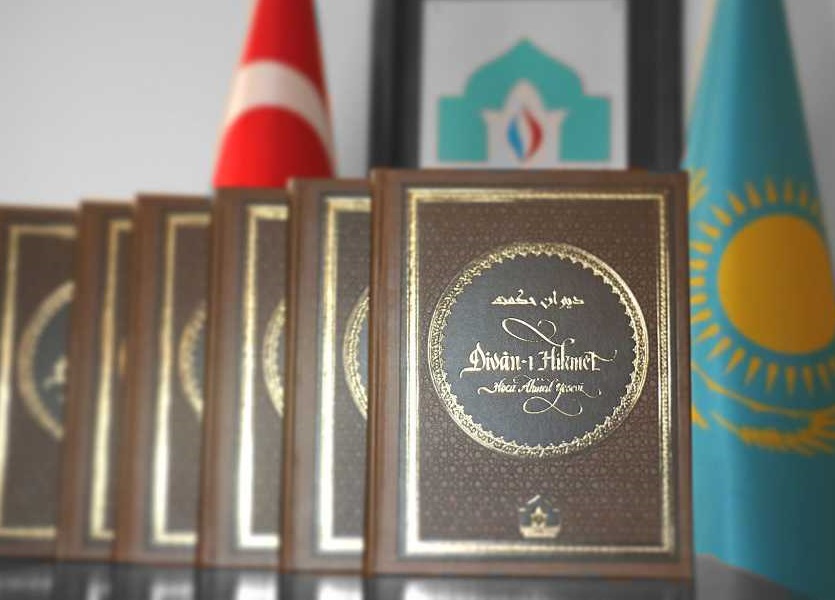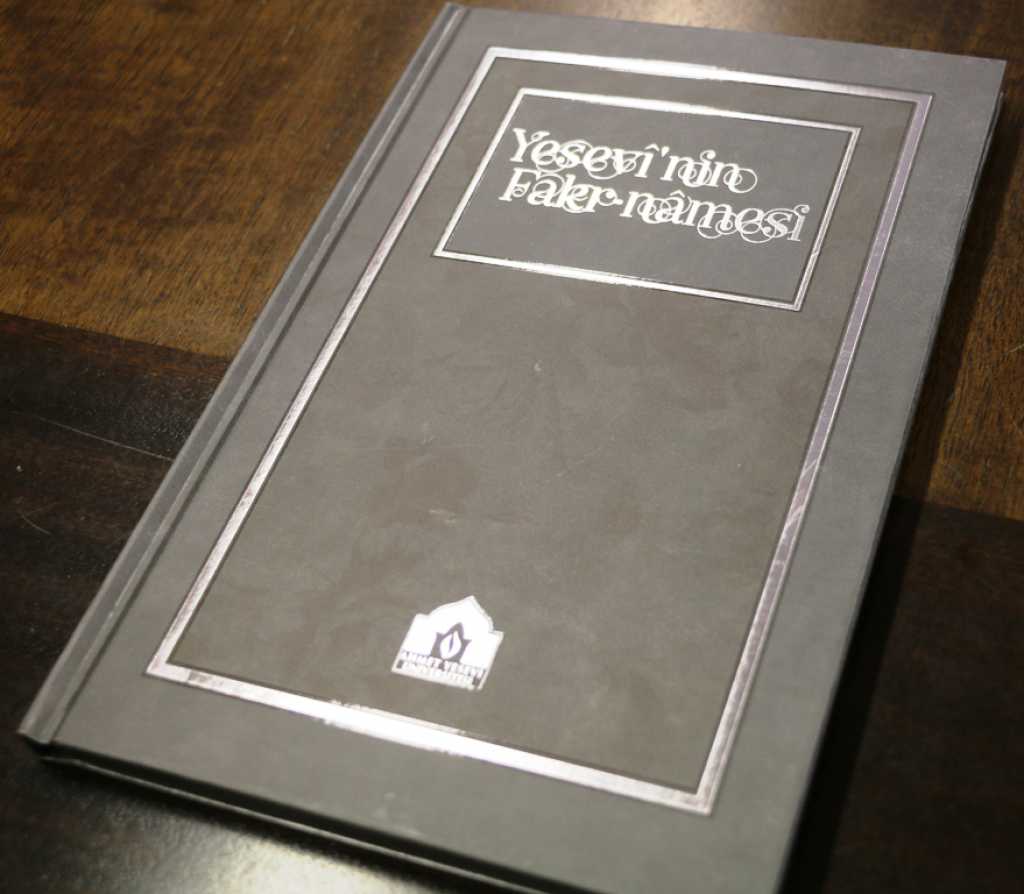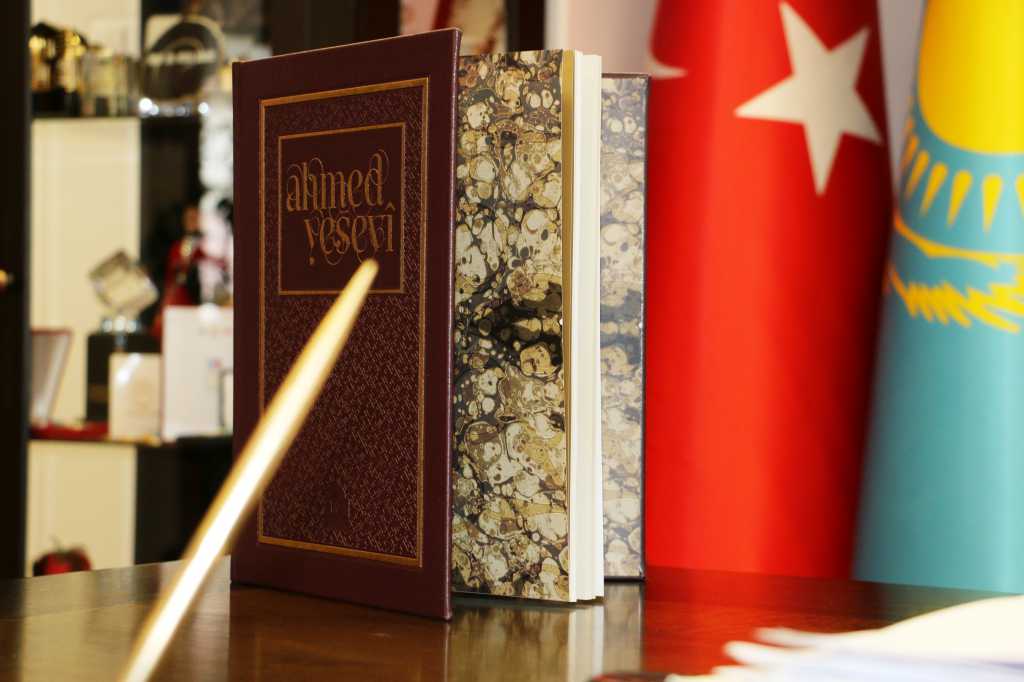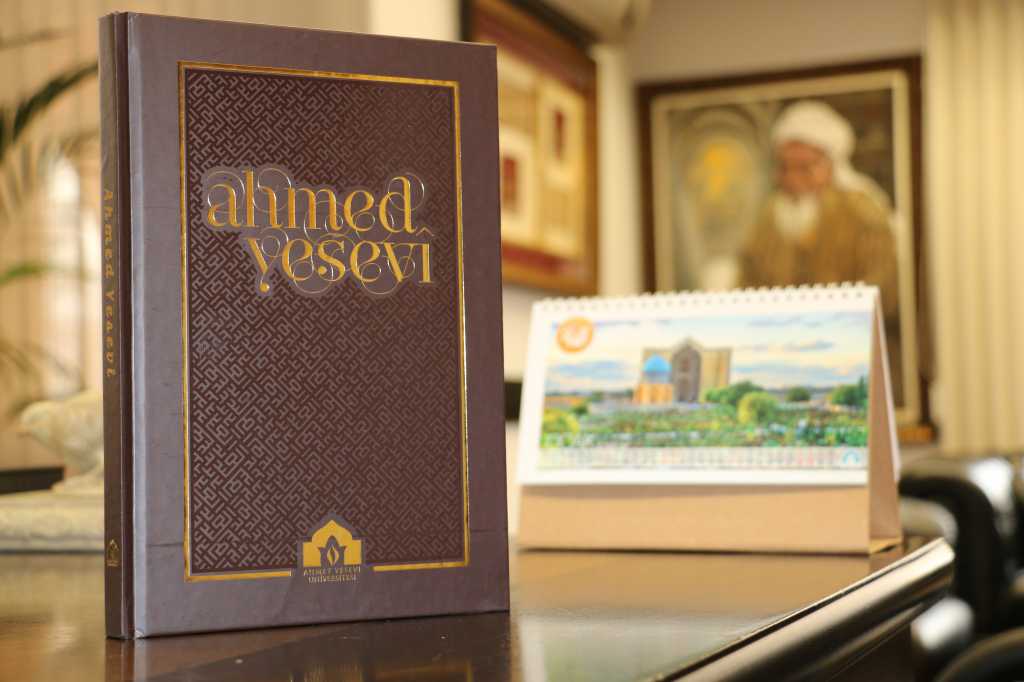

Akhmed Yassawi, the founder of the folk Turkic tradition of Sufism, who dominated the spiritual life of the Turks for centuries; through his “Hikmets” he transmitted to the people drop by drop the great heritage he received from Arystan Baba and spread it to all corners of the world with the enlightened disciples of Khorasan; “Pir-i Turkestan”, a great poet and teacher who made a great contribution to the development and enrichment of our language with his wisdom written in Turkic…
.jpg)
Historical documents and information about Akhmed Yassawi life, personality and influence are very limited. And the existing ones are full of legends. Yassawi was born in the town of Sairam, east of the Shymkent city. Sairam, which has been an important settlement since ancient times, is also known as Ispijab (Isfijab) or Akshehir. The exact date of Yassawi's birth is unknown, we can say that he was born in the second half of the 11th century, given that he was a student of Yusuf Al-Hamedani. Akhmed Yassawi's father - Sheikh Ibrahim, who was considered a descendant of Caliph Ali, was one of the important figures in Sairam, known for his miracles and legends. And the mother - Aishe Khatun, was the daughter of Sheikh Musa, one of Sheikh Ibrahim's followers. As the descendants of Imam Ali were called “Khoja” in Sairam, Akhmed Yassawi was also called Khoja Akhmed, Khoja Akhmed Yassawi, Kul Khoja Akhmed. Yassawi, who was the second child of Sheikh Ibrahim after a daughter named Gauher Shahnaz, first lost his mother and then his father. After some time, Gauher Shahnaz moved to the city of Yassy and they settled there. Khoja Akhmed began his education in Yassy and, despite his young age, attracted special attention with his knowledge. From early childhood he received a good education, studying Arabic, Persian and Islamic sciences.
According to legend, Yassawi met the holy Khyzyr and received his enlightenment from Arystan Bab, who is believed to have been an associate of the Prophet. Arystan Bab came to Yassy, found Akhmed and gave him the dates he had received from the Prophet, after which he engaged in his education. Thanks to Arystan Bab's education and guidance, Yassawi gained fame in a short time. After the death of Arystan Bab, Yassawi went to Bukhara, one of the important cultural centers of that period. There he became a disciple of the great scholar and Sufi sheikh Yusuf al-Hamedani, from whom he gained knowledge of religion and Sufism. Although he states in one of his quatrains that he joined Sheikh Yusuf-i Hamedani at the age of twenty-seven, the exact date is not given. After Yusuf al-Hamedani's death in 1140, his place was taken first by Abdullah Berki, then by Sheikh Hasan Endeki, and then by Akhmed Yassawi. Following the order of Sheikh Yusuf Al-Hamedani, after some time Yassawi left his place to Sheikh Abdul-Khalik Gijduvani and returned to Iasi, where he continued his mentoring activities until his death in 1166. According to stories, when Yassawi was sixty-three years old, he prepared a room underground - a hilvet - where he practiced worship and asceticism until his death. Since his date of birth is unknown, it is impossible to say anything definite about how many years he lived, but it is known that he lived ten years in the hilvet and died at the age of seventy-three, although some legends claim that he lived to the age of 120 and died in 1167. The ruler Timur, who lived two centuries later, believed that Akhmed Yassawi's miracles continued even after his death. Timur saw him in a dream where the saint told him the glad tidings of victory. Rumor has it that Timur built him a mausoleum precisely as a sign of reverence and gratitude. The tomb, built in two years, turned into a large complex with a mosque and a dervish cell. Later, the mausoleum, destroyed over time, was repaired by Abdullah Khan or Sheibani Khan. Akhmed Yasawi's mausoleum is visited all year round, especially during the month of Zul-Hijjah, and various celebrations and ceremonies are held here. Since it is widely believed that Akhmed Yassawi intercedes for those who are buried near his tomb, local people try to bury the dead closer to this place.
Diwani i Hikmet This is a collection of Yasawi's poems written in the Turkic language. The copies of Diwan-i Hikmet have significant differences in both language and content. This shows that the “Hikmets” were written or compiled by different people. New passages were added while compiling the Hikmets, some of which were lost or altered over time, thus the main text partially departed from its original. However, the basis of all wisdom lies in the beliefs and thoughts of Yassawi, as well as in the principles of his order. “Hikmet” is very important in establishing a unity of thought and views among the Turks. “Diwan-i Hikmet” has been published many times in old and new writing. The latest of these publications is the Akhmed Yassawi University Board of Trustees edition, which includes the original Chagatai spelling as well as a simplified modern Turkish transcription prepared by the linguist Hayati Bice.
This is a collection of Yasawi's poems written in the Turkic language. The copies of Diwan-i Hikmet have significant differences in both language and content. This shows that the “Hikmets” were written or compiled by different people. New passages were added while compiling the Hikmets, some of which were lost or altered over time, thus the main text partially departed from its original. However, the basis of all wisdom lies in the beliefs and thoughts of Yassawi, as well as in the principles of his order. “Hikmet” is very important in establishing a unity of thought and views among the Turks. “Diwan-i Hikmet” has been published many times in old and new writing. The latest of these publications is the Akhmed Yassawi University Board of Trustees edition, which includes the original Chagatai spelling as well as a simplified modern Turkish transcription prepared by the linguist Hayati Bice.
 The Fakir-nameh, attributed to Yassawi and written in Chagatai, is included in the Tashkent and some Kazan editions of the Diwan-i Hikmet. Fakir-nameh, which is a prose introduction to Diwan-i Hikmet rather than a separate treatise, was translated by Kemal Eraslan in 1977 and published as an article in the 22nd issue of the Journal of Turkish Language and Literature of Istanbul University. The Authorized Council of Akhmed Yassawi University published this article as a separate book.
The Fakir-nameh, attributed to Yassawi and written in Chagatai, is included in the Tashkent and some Kazan editions of the Diwan-i Hikmet. Fakir-nameh, which is a prose introduction to Diwan-i Hikmet rather than a separate treatise, was translated by Kemal Eraslan in 1977 and published as an article in the 22nd issue of the Journal of Turkish Language and Literature of Istanbul University. The Authorized Council of Akhmed Yassawi University published this article as a separate book.
 This is a small manuscript in Persian attributed to Yassawi, containing a total of forty regulations and rules, ten for each of the main tenets of Islam. The only copy known to date is in the Public Library of the Kütahya District. The work was translated from Persian into Turkish by Necdet Tosun and published by the Authorized Board of Trustees of Akhmed Yassawi University.
This is a small manuscript in Persian attributed to Yassawi, containing a total of forty regulations and rules, ten for each of the main tenets of Islam. The only copy known to date is in the Public Library of the Kütahya District. The work was translated from Persian into Turkish by Necdet Tosun and published by the Authorized Board of Trustees of Akhmed Yassawi University.
 This is also a small manuscript in Persian attributed to Yassawi, containing a total of forty regulations and rules, ten for each of the major tenets of Islam. The only copy known to date is in the Public Library of the Kütahya District. The work was translated from Persian into Turkish by Necdet Tosun and published by the Authorized Board of Trustees of Akhmed Yassawi University along with works such as Faker-nameh and Risale der Adab-e Tariqat.
This is also a small manuscript in Persian attributed to Yassawi, containing a total of forty regulations and rules, ten for each of the major tenets of Islam. The only copy known to date is in the Public Library of the Kütahya District. The work was translated from Persian into Turkish by Necdet Tosun and published by the Authorized Board of Trustees of Akhmed Yassawi University along with works such as Faker-nameh and Risale der Adab-e Tariqat.
 When Khoja Akhmed Yassawi died in 1166, he was buried about 100 meters from the underground cell, the hilvet, where he lived his last years. A small tomb was built here. The tomb quickly became a place of visitation for Muslims living in the area. However, the Mongol invasion that occurred in the early 13th century and the devastating effects of this invasion had a negative impact on the region. Emir Timur, who destroyed the Golden Horde at the end of the 14th century and took possession of the area, chose the daughter of the Mongol Khan, Tyukel Khanim, as his wife and traveled to meet the wedding cortege through the Yassy city, where he visited the tomb of Khoja Akhmed Yassawi. It is stated that during this visit Timur saw Akhmed Yassawi in a dream, who told him the glad tidings of victory. In gratitude the ruler ordered to build a huge mausoleum on the place of a small mausoleum. The construction of the complex was entrusted to Khoja Hussein Shirazi, one of the most famous architects of the Turkestan region of that time.
When Khoja Akhmed Yassawi died in 1166, he was buried about 100 meters from the underground cell, the hilvet, where he lived his last years. A small tomb was built here. The tomb quickly became a place of visitation for Muslims living in the area. However, the Mongol invasion that occurred in the early 13th century and the devastating effects of this invasion had a negative impact on the region. Emir Timur, who destroyed the Golden Horde at the end of the 14th century and took possession of the area, chose the daughter of the Mongol Khan, Tyukel Khanim, as his wife and traveled to meet the wedding cortege through the Yassy city, where he visited the tomb of Khoja Akhmed Yassawi. It is stated that during this visit Timur saw Akhmed Yassawi in a dream, who told him the glad tidings of victory. In gratitude the ruler ordered to build a huge mausoleum on the place of a small mausoleum. The construction of the complex was entrusted to Khoja Hussein Shirazi, one of the most famous architects of the Turkestan region of that time.

The complex is a rectangular structure with two domes, in the middle of the central hall is a large cauldron. On the edge of the cauldron, which is a mixture of seven metals, are engraved prayers and information about the master who cast the cauldron. It is believed that in the past, slightly sweetened water was poured into this cauldron and served to visitors after Friday prayers, and it was believed that this water had healing properties. In 1934 the cauldron was taken to an exhibition by order of Stalin, but was not returned, but placed in the Leningrad Hermitage in St. Petersburg. By efforts of Kazakhstan authorities in 1989 the cauldron again took its place in the mausoleum. Around this central part, which has a large dome, there are many rooms for various purposes, such as a kitchen (khalimkhane), a mosque, a library, cells of dervishes (khalvetan), and a well (kudukkhane).
In the central hall there is a tug (a standard with a bundle of horse tail), which is a symbol of the holy tomb in Central Asian culture. One of the doors leads to the Gurkhaneh room, where Ahmed Yassawi's tomb is located. One of the molded rings on the inside of the door, which is a work of wood carving, bears the date of its creation - 797 AH (1395). There is a small dome directly above the burial site. Yassawi's grave stone is made of light green stone. There are other tombstones in some rooms on the sides of the central part. Since the XVI century, some high-ranking and highly honored representatives of the Kazakh people were buried here. While the sides and the top of the mausoleum are decorated with tiles, the facade, where the entrance gate is located, is untreated. This situation is explained by the fact that the construction of the complex could not be completed after Timur's death and part of the tile decoration was missing. It is even claimed that part of the arch over the main entrance was left unfinished after Timur's death, and this arch was completed in 1000 AH (1591-92) by order and with the support of the Emir of Bukhara Abdullah Khan. Some of the logs used as a platform built during the time of Abdullah Khan have survived to this day.
On three sides of the tomb from the outside there are inscriptions - ayats from the Koran, decorated with tiles in the form of a belt running along the upper edge. These are ayats 59-63 of Surah Al-An'am. In addition, inscriptions such as “Allah”, “Muhammad”, “Al-Hamdu lillah”, “Allahu Akbar”, “La Ilaha Illallah” were engraved on the outside with tiles and Kufic calligraphy. A small tomb outside the mausoleum in the garden opposite the entrance gate is the tomb of Rabia Sultan Begim, daughter of Ulugbek and wife of Abul-Khair Khan.

 KZ
KZ TR
TR EN
EN RU
RU


